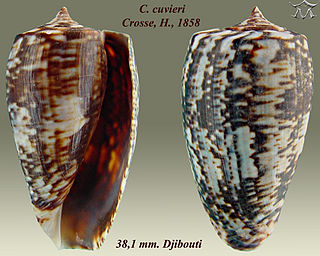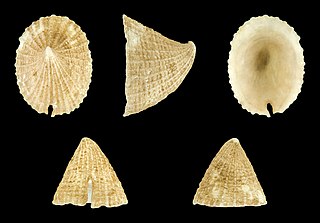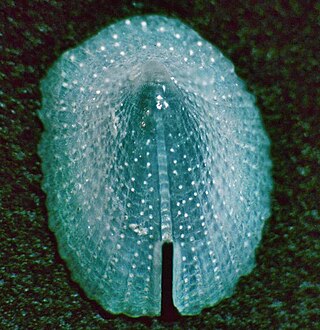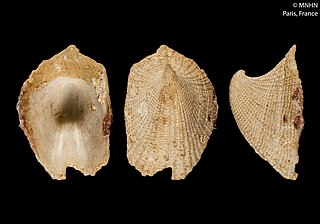
Fissurellidae, common name the keyhole limpets and slit limpets, is a taxonomic family of small to medium-sized limpet-like sea snails, marine gastropod molluscs in the clade Vetigastropoda.

Emarginula is a genus of small keyhole limpets, marine gastropod molluscs in the family Fissurellidae.

Conus cuvieri, common name Cuvier's cone, is a species of sea snail, a marine gastropod mollusk in the family Conidae, the cone snails and their allies.
Emarginula adriatica is a species of sea snail, a marine gastropod mollusk in the family Fissurellidae, the keyhole limpets.

Emarginula fissura, the common slit limpet, is a species of sea snail, a marine gastropod mollusk in the family Fissurellidae, the keyhole limpets.

Emarginula gigantea is a species of sea snail, a marine gastropod mollusk in the family Fissurellidae, the keyhole limpets.

Emarginula huzardii is a species of sea snail, a marine gastropod mollusk in the family Fissurellidae, the keyhole limpets.
Emarginula phrixodes is a species of sea snail, a marine gastropod mollusk in the family Fissurellidae, the keyhole limpets.
Emarginula retecosa is a species of sea snail, a marine gastropod mollusk in the family Fissurellidae, the keyhole limpets.

Emarginula rosea is a species of sea snail, a marine gastropod mollusk in the family Fissurellidae, the keyhole limpets.

Emarginula solidula is a species of sea snail, a marine gastropod mollusk in the family Fissurellidae, the keyhole limpets.
Emarginula tenera is a species of sea snail, a marine gastropod mollusk in the family Fissurellidae, the keyhole limpets.
Emarginula tenuicostata is a species of sea snail, a marine gastropod mollusk in the family Fissurellidae, the keyhole limpets.

The subfamily Emarginulinae, common name keyhole limpets and slit limpets, is a taxonomic subfamily of limpet-like sea snails, marine gastropod molluscs in the family Fissurellidae, the keyhole limpets and slit limpets.

Paromola cuvieri is a species of crab in the family Homolidae, the carrier crabs. It occurs in the eastern Atlantic Ocean and the Mediterranean Sea, from Angola to Norway, the Northern Isles and Iceland. It is demersal, occurring at depths of 10–1,212 metres (33–3,976 ft), but it is primarily found deeper than 80 m (260 ft). It prefers areas with mud and emerging rocks, and has been observed in deep-water coral gardens and sponge aggregations. It is locally common.

Emarginula bicancellata is a species of sea snail, a marine gastropod mollusk in the family Fissurellidae, the keyhole limpets and slit limpets.

Emarginula candida is a species of sea snail, a marine gastropod mollusk in the family Fissurellidae, the keyhole limpets and slit limpets.

Emarginula christiaensi is a species of sea snail, a marine gastropod mollusk in the family Fissurellidae, the keyhole limpets and slit limpets.

Emarginula thorektes is a species of sea snail, a marine gastropod mollusk in the family Fissurellidae, the keyhole limpets and slit limpets.

Cimoliopterus is a genus of pterosaur that lived during the Late Cretaceous in what is now England and the United States. The first known specimen, consisting of the front part of a snout including part of a crest, was discovered in the Grey Chalk Subgroup of Kent, England, and described as the new species Pterodactylus cuvieri in 1851. The specific name cuvieri honours the palaeontologist George Cuvier, whereas the genus Pterodactylus was then used for many pterosaur species that are not thought to be closely related today. It was among the first pterosaurs to be depicted as sculptures, in Crystal Palace Park in the 1850s. The species was subsequently assigned to various other genera, including Ornithocheirus and Anhanguera. In 2013, the species was moved to a new genus, as Cimoliopterus cuvieri; the generic name Cimoliopterus is derived from the Greek words for "chalk" and "wing". Other specimens and species have also been assigned to or synonymised with the species with various levels of certainty. In 2015, a snout discovered in the Britton Formation of Texas, US, was named as a new species in the genus, C. dunni; the specific name honours its collector, Brent Dunn.













